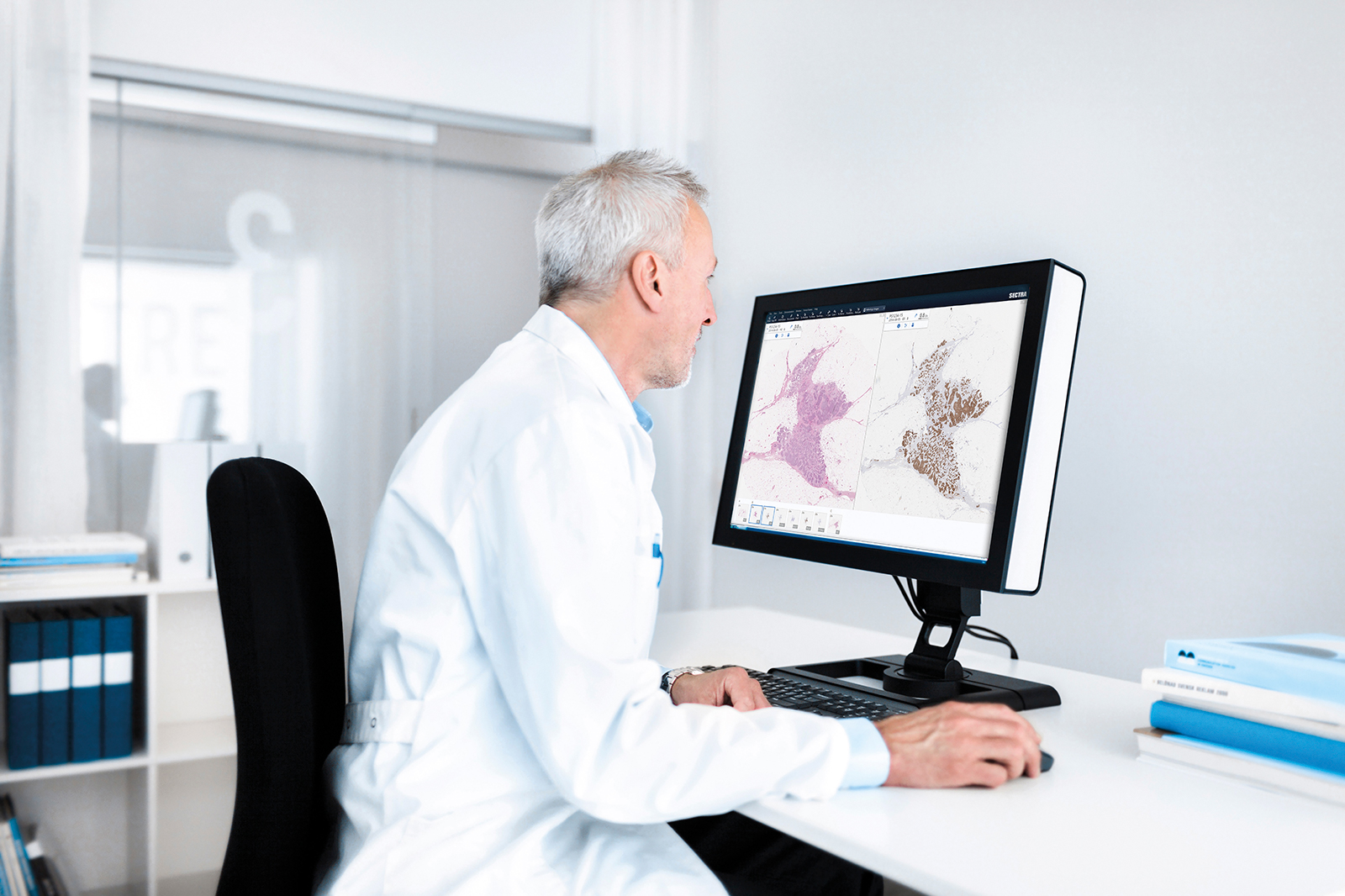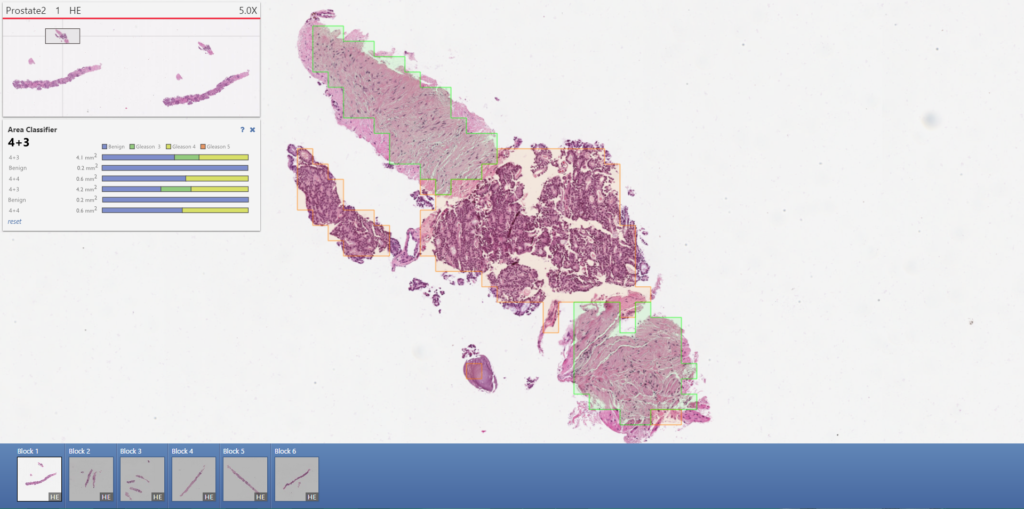Diagnostic review of pathology specimens is based on pathologists’ interpretation and measurements of the tissue. A number of formal measurement protocols, developed by the profession, are currently used to standardize the review. However, these protocols stipulate the use of intuition, eye-balling and judgements instead of exact measurements. Performing exact measurements would of course not be realistic, but the existing variation caused by this method of diagnosis poses a challenge. Especially since there is a lack of pathologists in most western countries and their workload is increasing and cases are becoming more complex. The effect is a high variability for many of the tumor characteristics that are typically found in a pathology report. When treatment decisions are based on these measurements, the variability turns into patient risk.
As digital pathology is adopted, it enables the use of algorithms to support pathologists’ review, thereby reducing variability. Although there are not enough clinical studies to prove its current value, many early adopters are reporting significant improvements in precision and quality by using image analysis applications. It is my firm belief that we will soon reach a point when, from a patient care perspective, it will be perceived as irresponsible to not take advantage of the efficient use of image analysis made possible through digital pathology.
How good are today’s interpretations?
Measurements made on the basis of the protocols mentioned earlier include protein expression, tumor cell concentration and nuclear pleomorphism. In a microscope workflow, these are often facilitated by tools such as transparent grids, pen and paper or mobile apps, which help pathologists to measure and keep count. However, many pathologists still rely heavily on their intuition, or eye-balling. The protocols used introduce an efficient sampling methodology and are designed and implemented to reduce the variability. But because different protocols may be used and because each pathologist’s intuitive measurements may be different, there is still a high variation in patient diagnosis, which may affect the treatment.
There are many studies that estimate the variability of a single protocol, but few that have studied the variability caused by using many different protocols. What has been proven though is that intuitive eye-balling estimations lead to a high variation between pathologists, which can impact patient treatments.
For example, immunohistochemistry analysis with Ki67 is widely used, but suffers from limitations due to a lack of uniformity and consistency. A difference in range of 1% to 5% can alter tumor grade, with potential implications for treatment. [2].
A study by Hamilton et al. [3] showed that the discrepancy in estimation of tumor cell concentration between two pathologists was greater than 20% in 37% of cases (51 of total 136). This is considered to be a high discrepancy as tumor cell concentrations are crucial to ensure sample quality and tumor DNA sufficiency for the manual microdissection. An error could undermine the precision of the molecular test and affect the treatment decision for the patient.
In the same study, precise benchmark cell counts were available in ten cases within this set. If a difference exceeding 10% from the benchmark number is considered unacceptable, only 50% of cases were considered correct [3].
Some studies have also investigated the preciseness of intuitive eye-balling measurements. Laura et al. (2012) found that when eye-balling Ki67 quantification, a significant discordance occurred between 18 of the total 45 observers. This was in contrast to image analysis and manual counting where no significant discrepancy was found [2]. This is supported by Laurinavicius et al. (2014), who showed that eye-balling cell counting for Ki67 breast cases underestimates the actual percentage compared with manual cell counting [4].
In conclusion, to reduce variability there is a strong need for new ways of performing quantifications according to protocols that eliminate the eye-balling approach.
The rise of image analysis
As a growing number of labs become digital, this is opening up new opportunities for making decisions quantitatively driven by utilizing image analysis tools. When the review is made on digital images instead of physical slides, algorithms can be applied that automatically or semi-automatically assist the pathologist in making more precise measurements, and as a consequence reduce variability and enable more accurate decisions.
However, poorly designed user interfaces of available image analysis tools have historically given image analysis a bad reputation. It has been viewed as being too slow to be used for routine practice. Image analysis applications need to be fast enough, intuitive to use and produce results that are on par with, or better than, a manual workflow. Accurate tools have existed for some time, but what has been lacking in terms of also being productive is a deep integration with the software for diagnostic review.
Today, there are commercially available products that, for example, can analyze and grade the ‘breast panel’, count cells automatically, test for PD-L1 positive, etc. with sufficient speed, usability and accuracy to improve the diagnosis. These applications are already used at some labs and in certain routine practices and are showing positive results.
Because of the benefits in terms of efficiency and accuracy, image analysis has become one of the key drivers for the adoption of digital pathology today.
So, will not using image analysis be seen as irresponsible?
Although technology is advancing rapidly, we need to be humble and realize that image analysis is not yet suitable for all protocols and applications. There is no doubt that image analysis will play a central role in how pathology will be able to handle increasing demands, govern the quality of diagnosis and standardize diagnosis protocols. Image analysis will most likely reduce the variability, and turn measurements and grading from estimations to quantitative and more precise results.
Pathologists utilizing these applications will have a comparative advantage and be able to produce more accurate pathology reports in less time than their colleagues still working in an analog fashion. I am confident that within the next two years we will reach a tipping point when the benefits have been proven to be sufficient. When we have reached that day, it might be seen as irresponsible not to use image analysis.
Sources
- http://www.aicr.org/press/press-releases/us-cancer-cases-rising.html
- https://www.ncbi.nlm.nih.gov/labs/articles/23026928/
- https://www.ncbi.nlm.nih.gov/pubmed/26317646
- https://www.ncbi.nlm.nih.gov/pubmed/24708745
- http://legeforeningen.no/Fagmed/Den-norske-patologforening/Nyheter/Fra-kronisk-til-akutt-Nytt-fokus-pa-ressursmangel-i-patologien/


